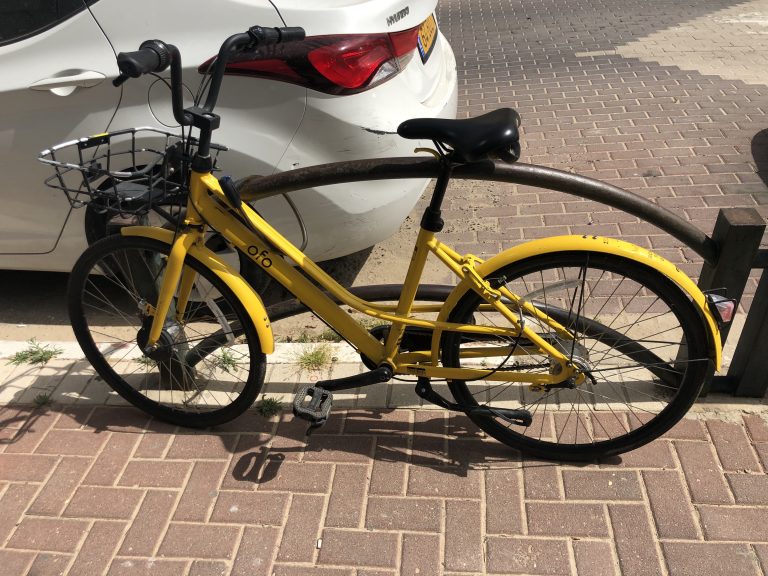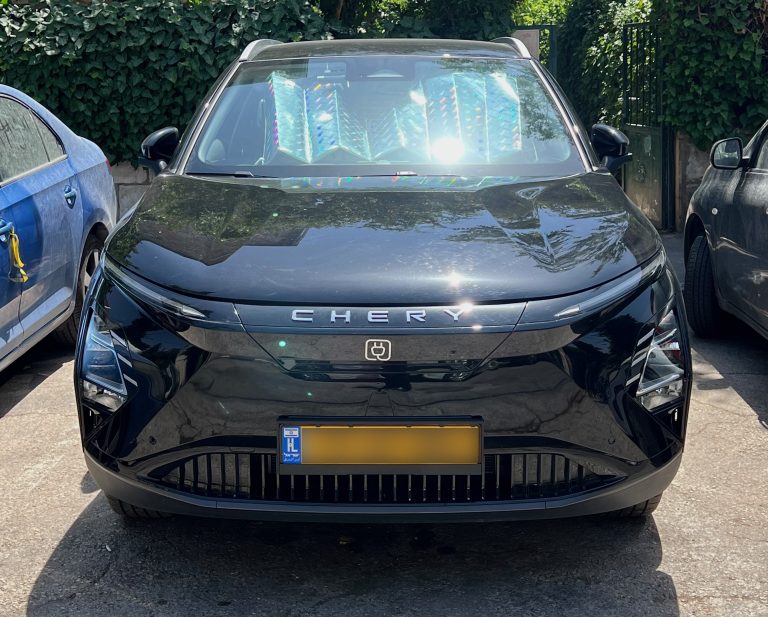Yesterday I spent some time at the Tel Aviv Port, a formerly run-down area that has been turned into a super-trendy nice-restauarant upscale-shopping area of the city. While having lunch at a restaurant facing the water, I did something I occasionally do when I’m in new place, I glanced at the ‘Near Me’ tab in the App Store on my phone. As is common, many of the apps that showed up were transportation related. This included an app called TeloBike (iTunes link), which provided information on the locations of bike rental stations in Tel Aviv, including how many bikes were available at each station. It worked pretty well, and operated in both Hebrew and English.
The data for this app presumably comes from the site run by the city of Tel Aviv for bike rentals, Tel-O-Fun. The site itself is not bad, provides a map of all the locations with the number of bikes available, and operates in Hebrew, Arabic, English, French, and Russian. The app Telobike itself is not from the city, or connected to the site directly, but was created by an independent developer. Why doesn’t the city have a mobile app itself? I’m not sure. More on that in a second.
After lunch my wife and I walked to the closest bike rental station and rented bikes. Not having done so before, or having read the web site before, we were not sure how it worked. The most surprising thing to me was that the ATM-like machine at the rental location only operated in Hebrew. I didn’t then know then that the web site was in five languages, but I was still surprised that the actual rental machine only worked in Hebrew. It could be because of the second thing I found odd, which is that it appears you need to give an Israeli ID number in order to rent a bike. I’m not sure what would happen if you entered a random number, but even if it did accept it, it was a bit strange that that was a requirement. However, if there was no desire to make these available to tourists then that might explain why the machine only operated in Hebrew.
The basic financial model seems simple. You buy a day pass for 17NIS (just under $5) and then pay for time used. Weekly and annual passes are available as well (the annual pass is slightly cheaper for Tel Aviv residents), and if I lived in Tel Aviv I’d probably want the annual pass, but the passes are just paper receipts, so I wonder how well they last after a year in a wallet.
If you use it less than 30 minutes, there’s no additional charge. An hour costs 5NIS ($1.43), 1.5 hours costs 10NIS, 2.5 hours costs 30NIS, 3.5 hours costs 70NIS, and 4.5 hours costs 150NIS. Each hour after that until 24 hours costs 100NIS. In other words, the first half hour is free, then each hour gets progressively more expensive. The first hour (really the second half hour) costs only 5NIS. The next half hour costs another 5NIS. The next hour then costs another 20NIS. The next, another 40NIS, etc. Clearly the idea is to get you to return the bicycles as quickly as possible. These bikes are meant for getting places, not for pleasant joy rides (unless quite short). Presumably, however, since you’ve paid for a day pass you can simply return the bike repeatedly at one of the many locations in under a half hour, and pay nothing, even if you’re using it all day. That being the case, it’s no clear to me why they insist on the ever-increasing hourly charge. Sure, keeping them within a half hour of one of their locations probably makes it easier to insure their bikes will get returned, but if you want to charge people for the convenience of not returning the bike quickly, why do you double the amount they pay every hour?
In any case, once you have your pass, you check out a bike. You select from one of the available bikes, and the lock disengages. You remove the lock from the bike and can now take the bike. It can be a bit hard to get the lock out in some cases. I watched a group of teens trying to get the bikes out when we were returning ours, and a couple of them had real difficulty getting them out.
The bike itself is a beast. I’m not expecting a carbon fiber or titanium bike here people, but this steel bike was incredibly heavy and bulky. Obviously the reason is it needs to stand up to lots of abuse. I get that. I just wish it was a bit lighter and easier to handle. The bike has a cargo strap on a curved surface on the back – useful for putting a bag on, but annoying to hop your leg over if that’s how you normally get on a bike. The bike has a built in lock that you can use if you want to park somewhere. The lock’s code is printed on your pass, a neat trick (i.e. the code travel with you from bike to bike).
The bike I chose (the closest to the terminal) was a bit beat up. The shifter casing was cracked open. I didn’t bother shifting gears (there were only 3) so I don’t actually know if the shifter worked. Overall, however, the bike seemed to work fine (other than being bulky) and it got me from point A to point B.
Without the app I had downloaded while at the restaurant, however, it would have been considerably more difficult to find a place to return the bikes. The web site of the service is not mobile-optimized. The papa per pass did have the web site address on it, as well as a phone number to call. Presumably I could have fallen back on the phone number if I couldn’t find a location to return the bikes.
Back to the app for a second, or rather lack of an app. The independent app was great, and very helpful, but it can’t do anything other than show you where there are bicycles. In a city like Tel Aviv, how is it possible they don’t have an app, or at least a really good mobile web site for the service? If I lived in Tel Aviv, would I really want to keep a paper pass safe for a year? Why not do everything electronically? The web site theoretically allows you to see your usage and invoices (I say theoretically because I could get neither to work in English, and only the usage to work in Hebrew). The paper pass has a bar code that you can insert into a covered section of the terminal to have it scanned. A slight redesign could allow scanning a smartphone screen if that was really needed. I say really needed, because why not allow unlocking a bike from the phone directly? Who needs the barcode? Imagine just going to a location, loading the app, having it recognize your location via GPS, show you the bikes that are available, and letting you pick one. Seems simple to me. It would also be nice to get a confirmation that the bike has been returned. A text message or e-mail would have been nice.
In the end, we had fun on the bikes, and returned them without a problem. It seems the city of Tel Aviv could improve things a bit, especially with the web site which has different parts that work in different languages. I would also think they’d want the bikes to be used by tourists, so offering a user interface on the rental terminals themselves in other languages would seem a must.
Rented a bike in Tel Aviv, or in the many other cities worldwide with rental bikes? What did you think of the experience?


